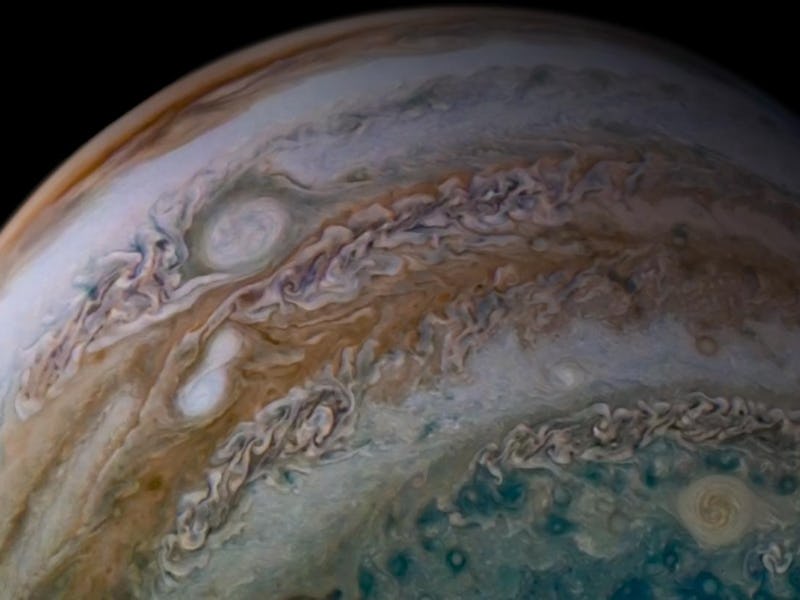Merging storms on Jupiter look like milk spreading in a planet-sized tea cup
NASA's Juno spacecraft captured the turbulent phenomenon in action for the first time.

The planet Jupiter is infamous for its storms. As the planet's gaseous layers shift and tangle, these storms can dance around one another and merge in a windy swirl, forming ever-larger storm cyclones.
New images captured by NASA’s Juno spacecraft reveal the turbulent process in stunning detail for the first time.
NASA released the color-enhanced images of a pair of merging storms this week. The images were put together using data from Juno's camera, the JunoCam.
The images detail a milky swirl of wind, trailing behind two oval shaped storms as they hug one another close, merging into an infinity-shaped cyclone.
To the right of this turbulent union is a larger storm, that astronomers believe to be the driving cause behind the smaller storms’ merger.
Juno captured a rare glimpse of two storms merging in Jupiter's atmosphere during a close flyby of the planet.
The merging storms are anticyclonic, which means they rotate counterclockwise. Astronomers have observed the larger of the two for years, watching it as it built momentum, growing in size by swallowing up smaller storms.
Storm mergers on Jupiter typically occur within a few days — a cosmically short amount of time. As a result, Juno had a pretty narrow window of time to capture this chaotic view. It managed to take the images during the spacecraft's 24th flyby of Jupiter, on December 26, 2019. At the time, the spacecraft was about 44,900 miles (72,200 kilometers) away from the tops of Jupiter's clouds, at a latitude of about 60 degrees South.
This particular merger is believed to have been caused by the looming presence of another, larger storm dubbed Oval BA, located just to the north.
Oval BA is one of the largest anticyclonic vortexes in Jupiter’s atmosphere — second only to the planet’s famous Great Red Spot.
This massive storm’s close proximity may have been the source of perturbations that caused the two smaller storms to merge together, according to a statement by NASA.
In fact, these images also provide scientists with the most clear view of Oval BA to date.
Stormy world
Juno launched in 2011. The spacecraft orbits Jupiter every 53 days, measuring the planet's atmosphere from afar.
Since its launch, it has provided unprecedented insight into Jupiter’s storms.
This composite image captured by Juno in 2018 shows a massive cyclone surrounded by eight smaller ones on Jupiter's north pole.
Scientists have observed Jupiter’s largest, and most famous, high-pressure storm, the Great Red Spot, since 1831. But before Juno was on the scene, they were less familiar with the planet’s smaller, more humble cyclones.
In March, 2018, a study detailed the characteristics of storms on Jupiter’s North and South poles for the first time, using data collected by Juno. The findings revealed that these cyclones, which take years to form and brew, are unlike anything else taking place in the Solar System.
And while they are not so huge as the Great Red Spot, they are still massive compared to our own, terrestrial storms.One of the storms, dubbed the North North Temperate Little Red Spot 1, stretches across 3,700 miles, the researchers reported at the time.
You can see more of the images collected by Juno via the NASA JunoCam website, here.